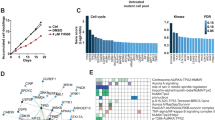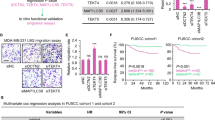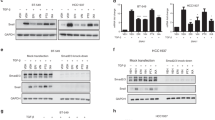Abstract
Taxol is one of the widely used chemotherapeutic drugs against many types of human cancer. While it is considered as one of the most effective anticancer drugs, treatment failure often occurs due to development of acquired resistance. Therefore, it is important to understand the molecular mechanisms responsible for the development of drug resistance. Although it is generally believed that taxol induces cell death through interfering with microtubules leading to mitotic arrest, recent evidence has suggested that taxol-induced cell death also occurs through pathways independent of either microtubule or mitotic arrest. In this study, we report the identification of a novel role for TWIST, a basic helix–loop–helix protein, which plays a central role in cell type determination and differentiation, during generation of acquired resistance to taxol in a nasopharyngeal carcinoma cell line, HNE1-T3, using comparative genome hybridization (CGH) and subsequent RT–PCR and Western blotting. We found that upregulation of TWIST was associated with cellular resistance to taxol but not other drugs with different mechanisms of action. The fact that increased TWIST protein levels were also associated with another microtubule-targeting anticancer drug, vincristine, in four types of human cancer including nasopharyngeal, bladder, ovarian and prostate, indicates that it may play a central role in the resistance to microtubule-disrupting agents. In addition, ectopic expression of TWIST into human cancer cells also led to increased resistance to both taxol and vincristine. Our results indicate a novel mechanism that leads to resistance to microtubule-disrupting anticancer drugs through upregulation of TWIST. Our evidence provides a therapeutic strategy to overcome acquired resistance through inactivation of TWIST expression in human cancer.
This is a preview of subscription content, access via your institution
Access options
Subscribe to this journal
Receive 50 print issues and online access
$259.00 per year
only $5.18 per issue
Buy this article
- Purchase on Springer Link
- Instant access to full article PDF
Prices may be subject to local taxes which are calculated during checkout






Similar content being viewed by others
References
Dumontet C and Sikic BI . (1999). J. Clin. Oncol., 17, 1061–1070.
Dupont J, Fernandez AM, Glackin CA, Helman L and LeRoith D . (2001). J. Biol Chem., 276, 26699–26707.
El Ghouzzi V, Le Merrer M and Perrin-Schmitt F . (1997). Nat. Genet., 15, 42–46.
Funato N, Ohtani K, Ohyama K, Kuroda T and Nakamura M . (2001). Mol. Cell. Biol., 21, 7416–7428.
Germann UA. . (1996). Eur. J. Cancer, 32A, 927–944.
Giannakakou P, Sackett DL, Kang YK, Zhan Z, Buters JT, Fojo T and Poruchynsky MS . (1997). J. Biol. Chem., 272, 17118–17125.
Glaser R, Zhang HY, Yao KT, Zhu HC, Wang FX, Li GY, Wen DS and Li YP . (1989). Proc. Natl. Acad. Sci. USA, 86, 9524–9528.
Gu SY, Tang WP, Zeng Y, Zhao EW, Deng WH and Li K . (1983). Chin. J. Cancer, 2, 70–72.
Guan XY, Fang Y, Sham JS, Kwong DL, Zhang Y, Liang Q, Li H, Zhou H and Trent JM . (2000). Genes Chromosomes Cancer, 29, 110–116.
Haldar S, Chintapalli J and Croce CM . (1996). Cancer Res., 56, 1253–1255.
Hjiantoniou E, Iseki S, Uney JB and Phylactou LA . (2003). Biochem. Biophys. Res. Commun., 300, 178–181.
Horwitz SB . (1992). Trends Pharmacol. Sci., 13, 134–136.
Howard TD, Paznekas WA, Green ED, Chiang LC, Ma N, Ortiz-de-Luna RI, Garcia-Delgado C, Gonzalez-Ramos M, Kline AD and Jabs EW . (1997). Nat. Genet., 15, 36–41.
Huang Y, Johnson KR, Morris JS and Fan W . (2000). Cancer Res., 60, 4426–4432.
Huang Y, Sheikh MS, Fornace A-JJ and Holbrook NJ . (1999). Oncogene, 18, 3431–3439.
Jordan MA, Toso RJ, Thrower D and Wilson L . (1993). Proc. Natl. Acad. Sci. USA, 90, 9552–9556.
Kavallaris M, Kuo DY, Burkhart CA, Regl DL, Morris MD, Haber M and Horwitz SB . (1997). J. Clin. Invest., 100, 1282–1293.
Lee MS, Lowe GN, Strong DD, Wergedal JE and Glackin CA . (1999). J. Cell Biochem., 75, 566–577.
Lin CT, Wong CI, Chan WY, Tzung KW, Ho JK, Hsu MM and Chuang SM . (1990). Lab. Invest., 62, 713–724.
Ling MT, Chan KW and Choo CK . (2001). J. Endocrinol., 170, 287–296.
Ling MT, Wang X, Ouyang XS, Lee TK, Fan TY, Xu K, Tsao SW and Wong YC . (2002). Oncogene, 21, 8498–8505.
Maestro R, Dei-Tos AP, Hamamori Y, Krasnokutsky S, Sartorelli V, Kedes L, Doglioni C, Beach DH and Harmon GJ . (1999). Genes Dev., 13, 2207–2217.
McDaid HM and Horwitz SB . (2001). Mol. Pharmacol., 60, 290–301.
Moos PJ and Fitzpatrick FA . (1998). Proc. Natl. Acad. Sci. USA, 95, 3896–3901.
Olson EN and Klein WH . (1994). Genes Dev., 8, 1–8.
Pajer P, Pecenka V, Karafiat V, Kralova J, Horejsi Z and Dvorak M . (2003). Oncogene, 22, 665–673.
Ranganathan S, Benetatos CA, Colarusso PJ, Dexter DW and Hudes GR . (1998). Br. J. Cancer, 77, 562–566.
Rauh-Adelmann C, Lau KM, Sabeti N, Long JP, Mok SC and Ho SM . (2000). Mol. Carcinogen., 28, 236–246.
Rosivatz E, Becker I, Specht K, Fricke E, Luber B, Busch R, Hofler H and Becker KF . (2002). Am. J. Pathol., 161, 1881–1891.
Rowinsky EK . (1997). Annu. Rev. Med., 48, 353–374.
Sosic D, Richardson JA, Yu K, Ornitz DM and Olson EN . (2003). Cell, 112, 169–180.
Thisse B, Stoetzel C, Gorostiza-Thisse C and Perrin-Schmitt F . (1988). EMBO J., 7, 2175–2183.
Urakami S, Igawa M, Kikuno N, Yoshino T, Kishi H, Shigeno K and Shiina H . (2002). J. Urol., 168, 2444–2450.
Wang X, Jin DY, Ng RW, Feng H, Wong YC, Cheung AL and Tsao SW . (2002). Cancer Res., 62, 1662–1668.
Wang X, Jin DY, Wong HL, Feng H, Wong YC and Tsao SW . (2003). Oncogene, 22, 109–116.
Yousfi M, Lasmoles F, El Ghouzzi V and Marie PJ . (2002). Hum. Mol. Genet., 11, 359–369.
Author information
Authors and Affiliations
Corresponding author
Rights and permissions
About this article
Cite this article
Wang, X., Ling, M., Guan, XY. et al. Identification of a novel function of TWIST, a bHLH protein, in the development of acquired taxol resistance in human cancer cells. Oncogene 23, 474–482 (2004). https://doi.org/10.1038/sj.onc.1207128
Received:
Revised:
Accepted:
Published:
Issue Date:
DOI: https://doi.org/10.1038/sj.onc.1207128
Keywords
This article is cited by
-
CDC20 promotes radioresistance of prostate cancer by activating Twist1 expression
Apoptosis (2023)
-
TRPM7 transactivates the FOSL1 gene through STAT3 and enhances glioma stemness
Cellular and Molecular Life Sciences (2023)
-
Twist alters the breast tumor microenvironment via choline kinase to facilitate an aggressive phenotype
Molecular and Cellular Biochemistry (2023)
-
Long Noncoding RNA CRNDE Functions as an Oncogene to Facilitate Aggressive Behaviors of Nasopharyngeal Carcinoma Cells by Modulating miR-3163/TWIST1 Axis
Molecular Biotechnology (2022)
-
Identification of a novel inhibitor of liver cancer cell invasion and proliferation through regulation of Akt and Twist1
Scientific Reports (2021)



